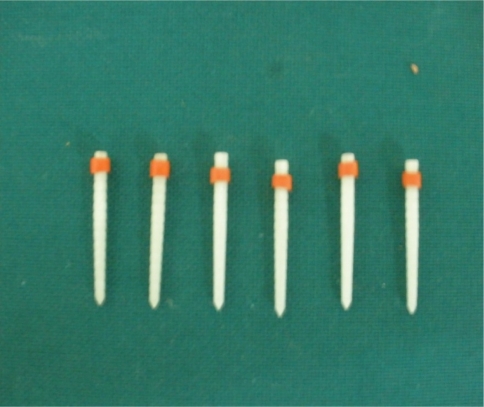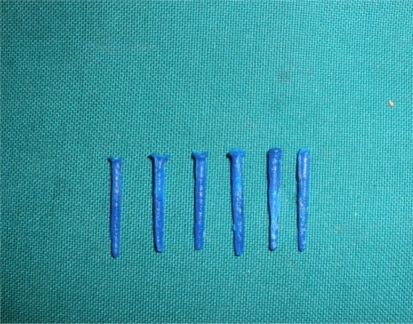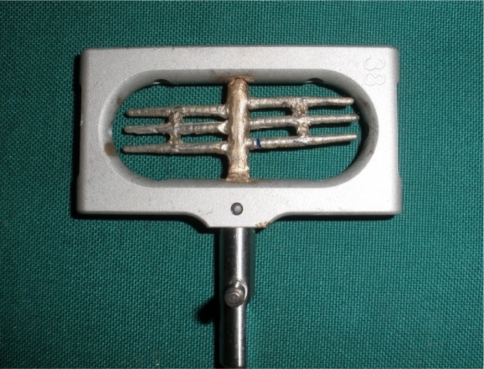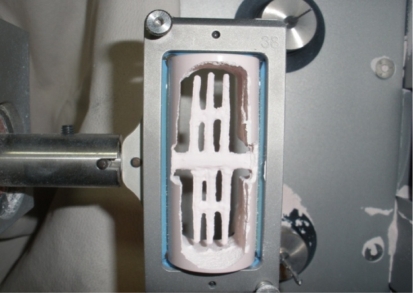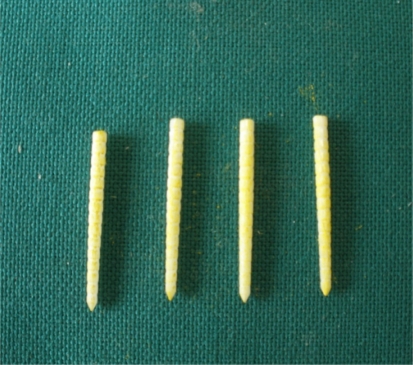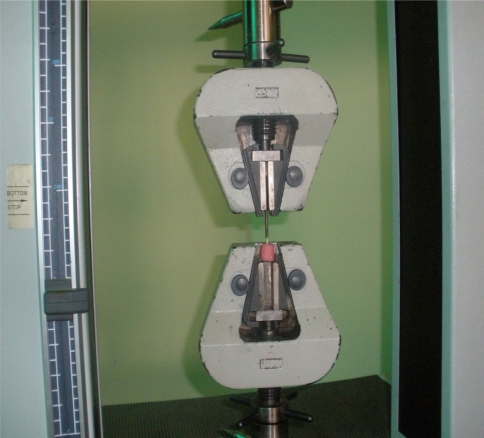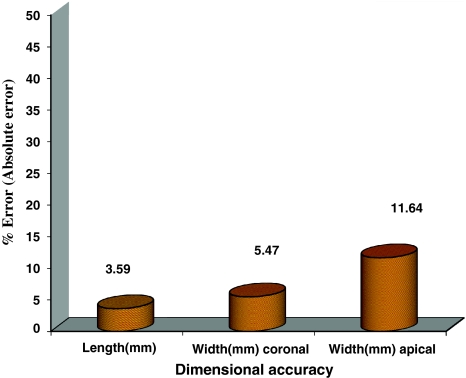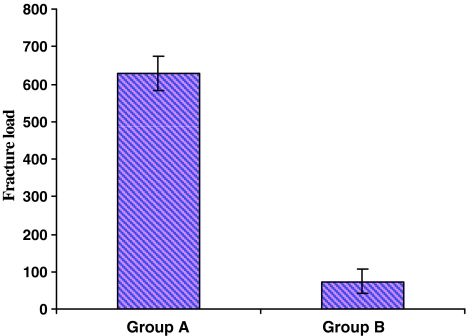Abstract
Post and core therapy is regarded as the treatment of choice for restoring severely damaged endodontically treated teeth. Critical control of endodontic materials in the coronal third of the canal and pulp chamber is essential in order to maintain its colour and translucency. In addition to this, the duplication of the optical characteristics of an intact tooth, including shade translucency and fluorescence is often made difficult by the use of metal infrastructures. As a result of this tooth colored posts have gained popularity especially in aesthetic areas. Besides aesthetics, the post is also responsible for transmitting the occlusal forces to the remaining tooth structure making the mechanical properties of the post critical. However, there is no clear consensus regarding an ideal system as far as strength of the post is concerned. Hence this study aims to analyses and compares the fracture strength of traditional prefabricated glass fibre posts with zirconium oxide posts constructed using CAD CAM technology.
Keywords: Zirconia post, Oxide ceramics, Glass fibre posts, CAD CAM, Copy milling
Introduction
The functional and aesthetic restoration of severely compromised endodontically treated teeth is a challenge to clinicians in their daily practice. The high demand for aesthetic restorations led to the development of a variety of tooth colored post systems. Metal free posts produce optical properties comparable to all ceramics crowns. These post systems are biocompatible, durable and exhibit lower fatigue rates and similar coefficient of thermal expansion as that of tooth structures. They are also aesthetic and easy to use [1, 2]. These include carbon fibre, epoxy resin, zirconia, glass fibre and high strength polyethylene fibre reinforced posts.
Among these materials, zirconia holds a unique place due to its superior mechanical properties. Though zirconia has been available for use in restorative dentistry for several years, there has been an increased interest in this material. The type of zirconia used in dentistry is yttria tetragonal zirconia polycrystals material, which is a zirconia oxide. This form of zirconia possesses superior properties than the other forms such as monoclinic and cubic form. Zirconia has been widely promoted by various CAD CAM systems as a superior material for restorations. Hence zirconia has to be compared with a material that is both aesthetic and has good mechanical properties for use as a restorative material. One such material is glass fibre which has been used for many years as an aesthetic post material. In vitro studies [3, 4] have shown that glass fibre might possess some benefits over metal posts due to their modulus of elasticity being closer to that of dentin.
Glass fibre posts can be made of different types of glasses such as electrical glass, S-glass, quartz-fibres and fibre reinforced composite posts. Electrical glass is the most commonly used glass type in which the amorphous phase is a mixture of SiO2, CaO, B2O3, Al2O3 and some other oxides of alkali metals [2]. Hence electrical glass was chosen as the material of choice in this study as comparative studies are required to substantiate such claims.
The aim of this research work was to study the use of zirconia based ceramics as well as glass fibre as a material for use in post and core restorations and also to assess the accuracy of zirconium oxide posts using the copy milling technique in which a customised wax or resin model is made using the indirect technique. The topography of this wax pattern was then used for copy milling and fabricating a zirconium oxide post.
Method
Pre fabricated glass fibre posts of specific dimensions (length 19 mm, width 1.2 mm coronal and 0.8 mm apical) were procured through commercial channels. These prefabricated posts were duplicated to construct experimental zirconium oxide posts using the following technique. Plastic poly vinyl chloride rings of 1 in. height and 0.5 in. width were cut from a commercially available pipe. The glass fibre post was embedded in the vinyl polysiloxane material placed in the pipe and the material was allowed to set. This helped in forming a putty index of the glass fibre post (Figs. 1, 2).The index was retrieved and sectioned along the midline. Inlay casting wax was then poured into the space occupied by the glass fibre post. The index was joined and placed in the pipe ring. This resulted in production of a wax pattern of the glass fibre post (Fig. 3). These wax patterns were then mounted on a frame designed for the cad cam unit, as many as six wax patterns could be mounted on the frame (Fig. 4). The wax patterns were then coated with silver oxide powder supplied by manufacturer of the CAD CAM unit. This frame was then mounted in its respective place on the cad cam machine.
Fig. 1.
Glass fibre posts (Prefabricated)
Fig. 2.
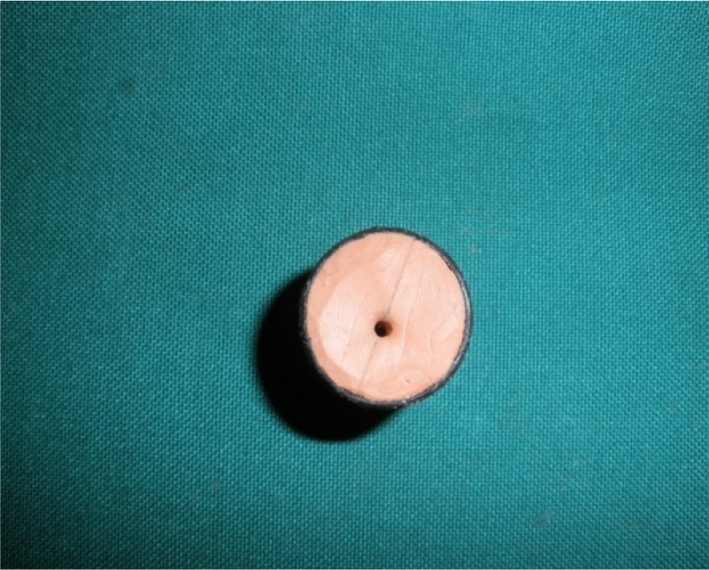
Putty index
Fig. 3.
Wax patterns
Fig. 4.
Wax patterns coated with silver oxide on mounting frame
The cercon cad cam unit used for this study consists of a milling unit which mills zirconium oxide blanks into desired restorations. The milling unit was attached with an adjacent scanning unit which is capable of scanning wax patterns coated with silver oxide powder and relaying the information to the milling arm which mills the zirconium blanks into the required dimensions. The milled structure is 30% larger than the wax pattern as zirconia undergoes a shrinkage of 30% after sintering of milled restorations. This sintering was done in a sintering unit provided by the manufacturer. The specimens were sintered for 6.5 h where the temperature of the unit goes up to 1,350°C. The restorations retrieved from the sintering unit are of the same dimensions as the scanned wax patterns as the shrinkage had completed. This method was employed to duplicate the glass fibre posts to zirconium oxide posts (Figs. 5, 6).
Fig. 5.
Copy milling of posts
Fig. 6.
Zirconia posts (Post sintering)
The specimens were divided into two groups:
Group A—Zirconium oxide posts (n = 15).
Group B—Glass fibre posts (n = 15).
The glass fibre posts and duplicated zirconium oxide posts were of similar dimensions and had to be tested for fracture strength and dimensional accuracy.
Assessment of Accuracy
A mechanical calliper was used to measure the zirconium oxide posts in length and width. The width was measured at the coronal and apical end of the posts and compared with the glass fibre posts.
Arrangement of Specimens for Testing
The specimens of both groups were mounted in acrylic resin blocks at an angle of 45 degrees using a mounting platform to guide in placing the posts at the specified angulation (Fig. 7).
Fig. 7.
Testing of specimens on universal testing machine
Testing of Specimens
The specimens were tested for fracture strength by applying load to the coronal portion of the posts using a universal testing machine at a constant cross head speed of 1 mm per minute. The values were collected and statistically analysed (Fig. 7).
Statistical Analysis
Descriptive statistical analysis has been carried out in the present study. Results on continuous measurements were presented on mean SD (Min–Max) and results on categorical measurements were presented in number (%). Significance was assessed at 5% level of significance. Student’s t test (two tailed, independent) has been used to find the significance of study parameters on continuous scale between two groups, percentage error has been computed for dimensional accuracy (Figs. 8, 9).
Fig. 8.
Accuracy of copy milling
Fig. 9.
Comparison of fracture strength
Results and Discussion
Endodontic treatment removes vital contents of the canal leaving the tooth pulpless and resulting in teeth with calcified tissues that contain significantly less moisture than vital teeth. It is the manipulation of the pulp chamber that leads to the weakening of an endodontically treated tooth. The roof of the pulp chamber has the configuration of an arch, which is extremely resistant to pressure and stress. When roof of the pulp chamber is removed for endodontic access, the inherent resistance of the endodontically treated tooth is greatly reduced. The loss of tooth structure makes retention of subsequent restorations more problematic and increases the likelihood of fracture during functional loading [4]. It is a well established fact that the longevity of post and core systems used to restore an endodontically treated tooth is affected by many factors such as the design, length and thickness of the post, material of fabrication and ferrule effect. [7] (Tables 1 and 2).
Table 1.
Assessment of accuracy of copy milling
| Dimensional accuracy | Group A | Group B |
|---|---|---|
| Length (mm) | 18.87 ± 0.35 | 19.00 ± 0.00 |
| Width (mm) coronal | 1.77 ± 0.05 | 1.80 ± 0.00 |
| Width (mm) apical | 0.77 ± 0.05 | 0.80 ± 0.00 |
| % Error (absolute error) | ||
| Length (mm) | 3.59% (0.133) | |
| Width (mm) coronal | 5.47% (0.0333) | |
| Width (mm) apical | 11.64% (0.0267) | |
Table 2.
Fracture strength of posts
| Fracture load | Group A | Group B |
|---|---|---|
| Minimum | 570.00 | 38.90 |
| Maximum | 720.00 | 159.30 |
| Mean | 627.79 | 74.28 |
| SD | 46.12 | 31.55 |
| Inference | Fracture load in Newton’s is significantly less in group B when compared to group A (627.79 vs. 74.28) with t = 38.361; P < 0.001** | |
The first fibre posts were made of carbon/graphite fibres due to their good mechanical properties. However, they were black in colour and thus lack cosmetic qualities. Although the flexural strength of fibre posts has been shown to be relatively high, large variations in the reported flexural modulus of carbon/graphite fibre posts can be found. The flexural properties were found to decrease after moisture adsorption [8, 9]. Glass fibres have a lower elastic modulus than carbon/graphite fibres. Many in vitro studies [3–5] have shown that glass fibre might possess some benefits over metal posts due to their modulus of elasticity being closer to that of dentin.
In 1989, Kwiatkowski and Geller [5] introduced the concept of a cast glass ceramic post and core with the rationale that they would not change the translucency or colour of the pulpless tooth. While outstanding esthetics were achieved, the glass ceramic was deficient in strength. Clinicians and manufacturers opined that a post material having a lower elastic modulus similar to dentin and tooth structure should be utilized while others believed that a high stiffness post distributes stresses better to the root and provides greater clinical longevity. Glass fibre posts had modulus of elasticity closer to dentine while zirconia posts have high stiffness hence both these materials are used as post materials [10, 11].
In dentistry, zirconia ceramics have the highest fracture toughness, a high weibull modulus and considerable flexural strength [12]. Superior mechanical properties and aesthetics of zirconia have made it a promising material for endodontic posts. Considering that all-ceramic crowns have a higher strength when supported by a higher elastic modulus substrate material the lower elastic modulus materials may be undesirable [13].
In the present study group A consisting of custom milled zirconium oxide posts showed significantly higher fracture load than group B consisting of prefabricated glass fibre posts. Fracture load in Newton’s is significantly less in group B when compared to group A (627.79 vs. 74.28) with t = 38.361; P = 0.001. Thus the result of the study indicates that copy milled zirconium oxide posts are much stronger than glass fibre posts of similar dimensions. Similarly Beck et al. [6] conducted a study in which experimental zirconia posts were produced from commercially available zirconia powder of two different diameters and these posts were loaded on a universal testing machine to test for fracture. Zirconium oxide posts exhibited higher fracture strength with values of 257.6 N for zirconia posts and 123.1 N for glass fibre posts.
The superior performance of custom milled zirconia posts with regard to fracture strength in the present study may be explained by the fact that these posts were industrially machined from wrought material consisting of hot isostatically pressed zirconia, the custom-made zirconia posts were copy milled from presintered zirconia blocks and sintered in the dental laboratory. As good clinical results have been reported for both prefabricated zirconia ceramic and glass fibre posts it can be inferred that copy milled zirconia ceramic posts are, from a mechanical point of view, well suited for clinical use. Since the post is primarily responsible for transmitting the occlusal forces to the remaining tooth structure and fundamentally serves to retain the core buildup, the physical properties of the post are critical. If the functional occlusal forces exceed the elastic limit of the post it will cause separation of the core due to permanent deformation of the post. However, strong the core material is it will breakdown resulting in either caries or dislodgement of the crown or fixed prosthesis.
Clinical Implications
Zirconium oxide posts can be recommended for restoration of anterior and posterior teeth as they have high fracture strength. Aesthetically, there may not be much difference when using zirconium oxide of glass fibre posts as both are available in tooth colored shades. Glass fibre posts can be recommended for restoration of anterior teeth in particular as they require a higher load to deform and show flexion.
Limitations of Study
The present in vitro study has a limitation of having a limited sample size. The specimens were not subjected to artificial aging, a single cycle was used for compressive testing, which does not represent the intraoral condition in which teeth undergo cyclic loading at varying velocities and magnitudes while being immersed in a wet environment that is subject to chemical and thermal changes.The present study also aimed to assess the accuracy of copy milling procedure using a certain CAD CAM system but the results cannot be compared to all CAD CAM systems as different systems use different technologies. The 3.59% error in the copy milling of the posts also suggests that the error could be an error in machining or due to inability of the scanner to record finer details on scanned patterns. The high cost of prefabricated zirconia posts often discourages dentists from using them, however using the copy milling technique described in this study dentists can fabricate custom post and cores for their patients.
Conclusion
This study described a method of fabricating zirconium oxide posts from pre fabricated glass fibre posts using the copy milling technique and testing the posts for fracture strength. The following conclusions can be drawn from this study.
Zirconium oxide posts showed higher fracture strength when compared to glass fibre posts.
Posts fabricated using CAD CAM showed a percentage error (3.59%) when compared with Glass fibre posts in length.
References
- 1.Noort RV. Introduction to dental materials. Missouri, USA: Mosby; 2005. [Google Scholar]
- 2.Qing H. In vitro evaluation of the fracture resistance of anterior endodontically treated teeth restored with glass fibre and zircon posts. J Prosthet Dent. 2007;97:93–98. doi: 10.1016/j.prosdent.2006.12.008. [DOI] [PubMed] [Google Scholar]
- 3.Pfeiffer P, Nergiz I, Schmage P. Yield strength of zirconia and glass fibre posts. J Oral Rehab. 2006;33:70–74. doi: 10.1111/j.1365-2842.2006.01526.x. [DOI] [PubMed] [Google Scholar]
- 4.Fokkinga WA, Kreulen CM, Le Bell-Rönnlöf A-M, Lassila LVJ, Vallittu PK, Creugers NHJ. In vitro fracture behavior of maxillary premolars with metal crowns and several post-and-core stems. Eur J Oral Sci. 2006;114:250–256. doi: 10.1111/j.1600-0722.2006.00357.x. [DOI] [PubMed] [Google Scholar]
- 5.Kwiatkowski SJ, Geller W. A preliminary consideration of the glass-ceramic dowel post and core. Int J Prosthodont. 1989;2:51–55. [PubMed] [Google Scholar]
- 6.Nina B. In vitro fracture resistance of copy milled zirconia posts. J Prosthet Dent. 2010;103:40–44. doi: 10.1016/S0022-3913(09)60214-6. [DOI] [PubMed] [Google Scholar]
- 7.Hattori M, Takemoto S. Durability of fiber-post and resin core build-up systems. Dent Mater J. 2010;29(2):224–228. doi: 10.4012/dmj.2009-113. [DOI] [PubMed] [Google Scholar]
- 8.Xilbe A. Effect of silica coating and silanization on flexural and composite resin bond strengths of zirconia posts. J Prosthet Dent. 2006;95:224–229. doi: 10.1016/j.prosdent.2005.12.010. [DOI] [PubMed] [Google Scholar]
- 9.Konstantinos X. Light transmission of posts and cores used for anterior esthetic region. Int J Periodontics Restorative Dent. 2004;24:462–469. doi: 10.11607/prd.00.0599. [DOI] [PubMed] [Google Scholar]
- 10.Fahad A, Nathanson D. In vitro assessment of retention of four esthetic dowels to resin core foundation and teeth. J Prosthet Dent. 2003;90:547–555. doi: 10.1016/j.prosdent.2003.09.014. [DOI] [PubMed] [Google Scholar]
- 11.Zachareyya S, Muhamed G, Mathias K. Effects of endodontic post surface treatment, dentin conditioning, and artificial aging on the retention of glass fiber reinforced compositeresin posts. J Prosthet Dent. 2010;103:31–39. doi: 10.1016/S0022-3913(09)60212-2. [DOI] [PubMed] [Google Scholar]
- 12.Sirimai S. An in vitro study of fracture resistance of and the incidence of root fracture of pulpless teeth restored with six post and core systems. J Prosthet Dent. 1999;81:262–269. doi: 10.1016/S0022-3913(99)70267-2. [DOI] [PubMed] [Google Scholar]
- 13.Rosenstiel SF, Land MF, Fujimoto J. Contemporary fixed prosthodontics. 4. St Louis: Mosby; 2006. [Google Scholar]



